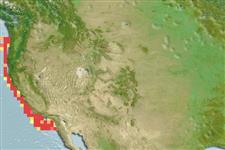>
Ophidiiformes (Cusk eels) >
Bythitidae (Livebearing brotulas)
Etymology: Cataetyx: Greek, kata = down + Greek, etix, stixo, stizo = to prick, to puncture.
More on author: Gilbert.
Environment: milieu / climate zone / depth range / distribution range
Écologie
marin bathydémersal; profondeur 300 - 1000 m (Ref. 34024). Deep-water; 46°N - 32°N
Eastern Pacific: northern Oregon, USA to Pacific coast of Baja California and the Gulf of California. Specimens from the Gulf of Panama and Chile either this species or still undescribed.
Taille / Poids / Âge
Maturity: Lm ? range ? - ? cm
Max length : 15.7 cm TL mâle / non sexé; (Ref. 38374)
Épines dorsales (Total) : 0; Rayons mous dorsaux (Total) : 100 - 114; Épines anales: 0; Rayons mous anaux: 74 - 86; Vertèbres: 59 - 63. scales present on body and head; eye diameter less than snout length; prominent opercular spine present; lateral ethmoid bone developed as a sharp retrorse suborbital spine; palatine teeth present; 3 well developed rakers on first arch; male intromittent organ on a broad, fleshy pad or stalk (Ref. 38374); branchiostegal rays: 8 (Ref. 36488).
Locally abundant (Ref. 34024). Juveniles mesopelagic, larger individuals benthic at depths of 600 to 1,000 m (Ref. 34024). Ovoviviparous with planktonic larvae (Ref. 36488).
Life cycle and mating behavior
Maturities | Reproduction | Spawnings | Egg(s) | Fecundities | Larves
Ovoviviparous (Ref. 36488).
Nielsen, J.G., D.M. Cohen, D.F. Markle and C.R. Robins, 1999. Ophidiiform fishes of the world (Order Ophidiiformes). An annotated and illustrated catalogue of pearlfishes, cusk-eels, brotulas and other ophidiiform fishes known to date. FAO Fish. Synop. 125(18):178p. Rome: FAO. (Ref. 34024)
Statut dans la liste rouge de l'IUCN (Ref. 130435)
Menace pour l'homme
Harmless
Utilisations par l'homme
Pêcheries: sans intérêt
Outils
Articles particuliers
Télécharger en XML
Sources Internet
Estimates based on models
Preferred temperature (Ref.
123201): 4.8 - 6.9, mean 5.3 °C (based on 9 cells).
Phylogenetic diversity index (Ref.
82804): PD
50 = 0.5002 [Uniqueness, from 0.5 = low to 2.0 = high].
Bayesian length-weight: a=0.00457 (0.00179 - 0.01169), b=3.10 (2.87 - 3.33), in cm total length, based on LWR estimates for this (Sub)family-body shape (Ref.
93245).
Niveau trophique (Ref.
69278): 3.4 ±0.5 se; based on size and trophs of closest relatives
Résilience (Ref.
120179): Milieu, temps minimum de doublement de population : 1,4 à 4,4 années (Assuming tmax>3).
Fishing Vulnerability (Ref.
59153): Low vulnerability (10 of 100).
